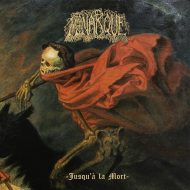 I am not the black metal scholar that some of my colleagues definitely are, and this is my first encounter with Canadians Monarque and the proudly independent black metal scene of Quebec. But like every new convert to anything, what I lack in knowledge, I make up in enthusiasm. Also, this is Monarque’s first release in six years, so I hope I will be forgiven for not being aware of them. In any case, what I know about music in general and black metal in particular is enough to tell that Jusqu’á la Mort [until death], the EP at hand, is not only good, but excellent.
I am not the black metal scholar that some of my colleagues definitely are, and this is my first encounter with Canadians Monarque and the proudly independent black metal scene of Quebec. But like every new convert to anything, what I lack in knowledge, I make up in enthusiasm. Also, this is Monarque’s first release in six years, so I hope I will be forgiven for not being aware of them. In any case, what I know about music in general and black metal in particular is enough to tell that Jusqu’á la Mort [until death], the EP at hand, is not only good, but excellent.
The cover of Jusqu’á la Mort features a detail from a Renaissance-style painting by German painter Theodor Baierl titled “Ritter mit Tod” [knight with death]. Personified death is wrapped in a red cloak, riding on an emaciated, pitch-black horse, the wind in his garment. The red cloak is worth pointing out, because it might be a reference to British soldiers (redcoats), and thus to parts of Quebecois history, that have been thematised before by black metal bands from Quebec. If your knowledge of this particular part of history is as foggy as mine, you might want to read an interview we did with Forteresse, one of the best known of these bands. This will provide you with a bit of context on what Quebecoise black metal is all about.
To enjoy every detail of Monarque’s sound you will have to equip yourself with a good set of headphones, or alternatively listen to the EP on a very good stereo, otherwise you’ll be missing out.
The EP kicks off with the title track Jusqu’á la Mort, a fast piece with a very good portion of rebellious punk in the drumming. The atmosphere is appropriately dark and gloomy, spherical tunes from keyboards or synth add melancholia, and the echo on the vocals provides a bit of spookiness. One of my favourite details is a rattling distortion sound the source of which is difficult to pinpoint. I like it, because it makes the sound deliberately unclean.
The second track, Le Serment Prononcé [the pronounced oath], is somewhat slower, featuring a more traditional, melodious black metal sound, but nothing weaker in effect or character. The vocals are unchanged, and rightly so, since they are first-rate the way they are. Early on, an acoustic guitar creates a historical connection, a connection to times past. The track ends in a prolonged silence, a void of sorts.
Le Grand Deuil [the great mourning], the EP’s closing track, is definitely a case of saving the best for last. In my humble opinion, it is the most impressive piece on the EP. First, we hear a bell tolling and a raven calling. After that, a profoundly sad melody, doing the track title credit, is played out on a cello (I think). The melody has a Mediterranean feel to it and, like the acoustic guitar in the previous track, it is a classic example of how a piece of music can evoke not only certain moods and feelings, but also establish links to bygone times and historical events. But this is just the track’s beginning. What follows is breath-taking, sweeping, merciless black metal, with the fine melody preserved in the undercurrent. Halfway through the track, the cello returns, only to be squashed even harder by the black metal assault. For the most part, Le Grand Deuil is an instrumental, only a little bit of lyrics can be heard towards the end.
Jusqu’á la Mort is a grand return indeed. This is superb black metal, if you ask me. The EP’s three tracks are just enough to water your mouth and make you wish for more. I’m looking very much forward to the album. Until then, I’ll dig around the Quebecoise black metal scene a bit, because it seems to me that it has some beautifully dark pearls to offer.
(9/10 Slavica)

Leave a Reply